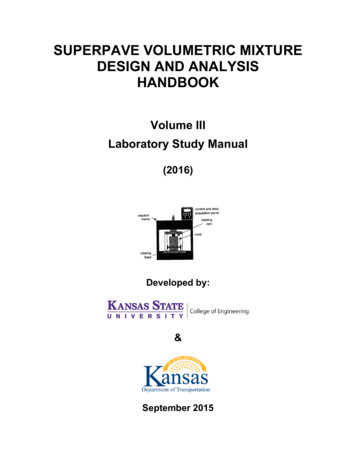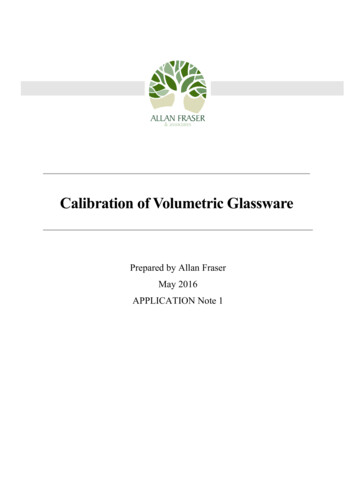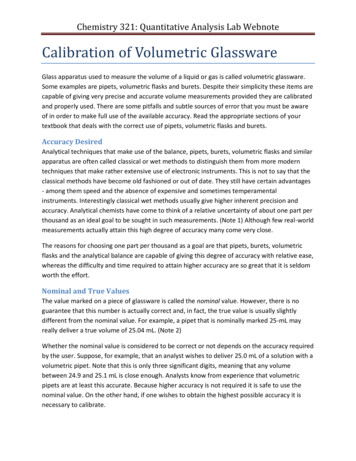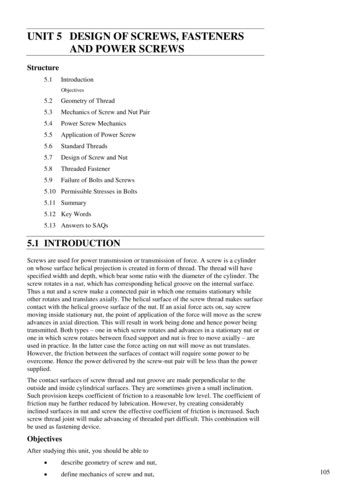
Transcription
SUPERPAVE VOLUMETRIC MIXTUREDESIGN AND ANALYSISHANDBOOKVolume IIILaboratory Study Manual(2016)Developed by:&September 2015
Compiled by:Mustaque Hossain, Ph.D., P.E.Department of Civil EngineeringKansas State UniversityManhattan, Kansas 66506andGlenn Fager, P.E. (retired)Rodney G. Maag, P.E. (retired)Kansas Department of TransportationTopeka, Kansas 66603Superpave Laboratory Study Manual (Volume III)1
Table of ContentsTopicPage KT-58 / AASHTO T312, Method for Preparing and Determining the Density of HotMix Asphalt (HMA) Specimens by Means of the Superpave GyratoryCompactor.5 KT-15 / AASHTO T166, Bulk Specific Gravity and Unit Weight of CompactedAsphalt Mixtures.19 KT-39 / AASHTO T209, Theoretical Maximum Specific Gravity of Asphalt PavingMixtures.26 KT-57 / AASHTO T308, Determining the Asphalt Content and Gradation of HotMix Asphalt Concrete by the Ignition Method.34 KT-56 / AASHTO T283, Resistance of Compacted Asphalt Mixture to MoistureInduced Damage.43 Answers to Review Questions.53Superpave Laboratory Study Manual (Volume III)2
PrefaceThis study manual has been developed by heavily drawing from the M-TRAC training manualdeveloped under the sponsorship of the Federal Highway Administration (FHWA). The MTRAC manual was a part of a multi-regional effort to assist states with meeting the requirementsof the Code of Federal Regulations, Part 637, for “qualified” personnel to perform materialsampling and testing for quality control and quality acceptance (QC/QA). The ultimate goal ofthe group was also to promote reciprocity of this “qualification” across state lines. Thedevelopment team members were Tom Deddens, formerly with the Asphalt Institute, JohnHinrichsen, Asphalt Technician of the Iowa Department of Transportation, and RebeccaMcDaniel, Technical Director of the North Central Superpave Center at Purdue University. Theauthors of this compilation acknowledge and appreciate this pioneering effort to have uniformityin training for bituminous material sampling and testing.This study manual is intended to give an introduction to the tests that will be taught in theSuperpave Field Technician (SF) Training classes at Kansas State University. The Kansas testmethods are listed in the “Table of Contents” for this volume. References to other standards arelisted on the first page of each test method. Knowledge of certain methods and tests is necessarybefore proceeding to other standard tests.Training participants are expected to use the mathematical rounding rules recommended byKDOT in performing calculations for qualification testing.Superpave Laboratory Study Manual (Volume III)3
METHOD FOR PREPARING AND DETERMININGTHE DENSITY OF HOT MIX ASPHALT (HMA)SPECIMENS BY MEANS OF THE SUPERPAVEGYRATORY COMPACTOR(Kansas Test Method KT-58 / AASHTO T312)Superpave Laboratory Study Manual (Volume III)4
NOTEThis discussion and KT-58 refer to thefollowing KT Methods:*KT-6/AASHTO T84 & 85, SpecificGravity and Absorption of Aggregate*KT-15/AASHTO T166, Bulk SpecificGravity and Unit Weight of CompactedAsphalt Mixtures*KT-25/AASHTO T168, StandardMethod of Test for SamplingBituminous Paving Mixtures*KT-39/AASHTO T209, TheoreticalMaximum Specific Gravity of AsphaltPaving Mixtures*KT-56/AASHTO T283, Resistance ofCompacted Asphalt Mixture to MoistureInduced DamageSuperpave Laboratory Study Manual (Volume III)5
GLOSSARYCx Correction factor for specific gravity after “x” number of gyrations (Cx hfinal / hx)hx Height after "x" number of gyrationshfinal Height after final/maximum number of gyrationsCorrected %Gmm the density of a specimen determined at x number of gyrations andexpressed as a percentage of the maximum theoretical specific gravity of the mixture, correctedfor the fact that it has been determined based on the bulk density of the Superpave gyratoryspecimen compacted to the maximum number of gyrations.N-initial (Nini ) the initial number of gyrations, a relatively low number of gyrations based onthe design traffic volume, and used to analyze the early densification properties of the Superpavemix during construction.N-design (Ndes ) the design number of gyrations, also based on the design traffic level, andused in the design of Superpave mixture.N-maximum (Nmax ) the maximum number of gyrations applied to a specimen, based on thedesign traffic volume, and used to assess the densification properties of the Superpave mixtureafter many years in service.Superpave Laboratory Study Manual (Volume III)6
PREPARING AND DETERMINING THE DENSITY OF HMASPECIMENS BY MEANS OF THE SUPERPAVE GYRATORYCOMPACTORCompacted samples of the Superpave mix are used to determine the volumetric and mechanicalproperties during the mix design phase and for quality control/quality assurance duringconstruction. These volumetric properties are then evaluated to select a mix design or to controlthe mixture quality during production. The specimens produced with the Superpave gyratorycompactor very closely simulate the density, aggregate orientation and structural characteristicsof the mixture on the actual roadway.The gyratory compactor is used to prepare specimens for later analysis of the volumetricproperties of the mixture, evaluation of mixture densification properties, evaluation of moisturesensitivity, field quality control and/or other testing purposes.This text will explain the method of compacting samples of the Superpave mix using theSuperpave gyratory compactor and determining their percent compaction. This method may beused with laboratory-prepared specimens, as in the mix design process, or with plant-mixedmaterial during construction.Common Testing Errors Not placing a paper protection disk at the bottom or on the top of the specimen. Not placing the top plate. Not preheating the mold and base plate. Not charging the mold with mix quickly, in one lift without spading or rodding. Not compacting the mixture at proper temperature. Not removing the paper disks while the specimen is still warm.Superpave Laboratory Study Manual (Volume III)7
TEST METHODOLOGYApparatus Superpave Gyratory Compactor: The compactor may also include a printer or a computerand software for collecting and printing the data. (Pine AFGC125X referenced in thismanual)Specimen molds, and top and bottom platesThermometerBalance readable to 0.1 gOven, thermostatically controlled with a range from 50 to 260oC with 3oC toleranceCalibration equipment recommended by compactor manufacturerSafety equipment: insulated gloves, long sleeves, etc.Miscellaneous equipment: paper disks, lubricating materials recommended by compactormanufacturer, scoop or trowel for moving mixture, funnel or other device for ease ofloading mixture into mold (optional).CalibrationThe means of calibrating the gyratory compactor vary with different manufacturers. Refer to theoperation manual of the particular brand and model of gyratory available for use. Calibration ofthe following items should be verified at the noted intervals of the Contractor’s Quality ControlPlan approved by the State or according to manufacturers’ recommendations (as nterval (months)HeightRecord to nearest 0.1 mm,Compact to 115 5 mm12*Angle (Internal)1.16 0.0 12*Pressure600 18 kPa30.0 0.5 gyrations perSpeed of Rotationminute*6 for large Pine Models AFGC125X12*12*Mold and plate dimensions, hardness and smoothness should also be verified. Oven temperatureshould be verified; oven must be capable of maintaining the temperature as required for shortterm aging according to KT-58 section 4.2.Superpave Laboratory Study Manual (Volume III)8
Sample PreparationSamples for compaction in the gyratory may be obtained in one of two ways; mixture may beprepared in the laboratory or plant-mixed material may be obtained from the roadway behind thepaver.For determination of volumetric properties for mix design or quality control, a finished specimenheight of 115 5 mm is required. When compacting specimens for testing in KT-56, Resistanceof Compacted Bituminous Mixture to Moisture Induced Damage, a specimen height of 95 5mm is required. In this case, the batch mass must be varied to provide the desired specimenheight at a specified air void content; samples are then compacted to the specified height ratherthan for a fixed number of gyrations (See KT-56 for more details.)Laboratory Prepared MaterialsPreparing samples of mixture in the laboratory requires batching out the aggregates, mixingproper amount of asphalt binder, conditioning the prepared mixture, heating the mixture tocompaction temperature, and compacting the specimen. The steps involved in preparing themixture in the laboratory are as follows:1. Weigh out appropriate amounts of the required aggregate size fractions and combine in a bowlto the proper batch mass. Typically, a batch mass of 4,500 grams of aggregate will provideenough material for a finished specimen height of 115 5 mm.2. Heat the asphalt binder and the combined aggregate in an oven to the appropriate mixingtemperature for the binder to be used. This temperature is determined from an equi-viscoustemperature chart or will be provided by the binder supplier. The appropriate temperature rangefor mixing is defined as the range of temperatures that produces a viscosity of 0.17 0.02 Pa·sfor the unaged binder. This ensures that the binder is fluid enough to coat the aggregate particles.Some modified binders do not follow these temperature-viscosity relationships; themanufacturer’s recommendations should be followed.3. The heated aggregate should be placed in the mixing bowl and thoroughly dry mixed. Make acrater at the center of the aggregate in the bowl and weigh in the required amount of asphaltbinder. Begin mixing immediately.4. A mechanical mixer is recommended for preparing laboratory mixtures. Mixing shouldcontinue until the asphalt binder is uniformly distributed over the aggregate particles.5. Determine the proper compaction temperature range for the asphalt binder used. This isdefined as the range of temperatures that yields a binder viscosity of approximately 0.28 0.03Pa·s. Modified binders may not conform to these mixing and compaction temperatures, so themanufacturer’s recommendations should be followed.6. After mixing, spread the loose mixture in a flat, shallow pan and short term age it as follows:Superpave Laboratory Study Manual (Volume III)9
Place the mixture on a baking pan and spread it to an even thickness. Place the mixtureand pan in the aging oven set at compaction temperature 2 hours 5 minutes at thespecified mixture’s compaction temperature. The compaction temperature variesdepending on the grade of binder used and can be determined from state specifications orthe binder supplier’s recommendations. (Note: The compaction temperature range of anHMA mixture is defined as the range of temperatures where the unaged asphalt binderhas a kinematic viscosity of 280 30 mm2/S (approximately 0.28 0.03 Pa·s) measuredin accordance with ASTM D4402. The target compaction temperature is generally themid-point of this range. When using modified asphalts, the binder manufacturer’srecommendation for compaction temperature should be considered.)Stir mixture every 60 5 minutes to maintain uniform aging.After 2 hours 5 minutes, remove the mixture from the oven. The aged mixture is nowready for further tests.7. Place the mold and base plates in an oven permitting the pieces to reach the establishedcompaction temperature prior to the estimated beginning of the compaction process.Plant-Mixed MaterialsWhen plant-mixed materials are sampled from the roadway behind the paver (KT-25), no agingor conditioning is required. The mixture must be brought to the proper compaction temperaturethen compacted and analyzed if the temperature of the mixture has dropped below thecompaction temperature. Place the material in an oven at the compaction temperature and bringthe mixture to the proper temperature by careful, uniform heating. The mix should be stirredperiodically to help assure uniform heating. In general, the shortest heating time that will bringthe mixture to the compaction temperature is preferred. Avoid over-heating the mix. When thecompaction temperature has been reached, proceed with specimen compaction as outlined below.Compaction ProcedureOnce the mixture sample has reached the proper compaction temperature, it is compacted in theSuperpave gyratory compactor. For most purposes, the finished specimens will be used tocalculate volumetric properties and the specimens will be compacted to a fixed number ofgyrations. When preparing specimens for testing under KT-56, Resistance of CompactedBituminous Mixture to Moisture Induced Damage, specimens may be compacted to a fixedheight to produce a specified air void content.The procedure to compact to a fixed number of gyrations is as follows:1. Ensure that the gyratory compactor has been turned on and allowed to warm up for the timerecommended by the manufacturer. Verify all settings for angle, pressure and number ofgyrations.Superpave Laboratory Study Manual (Volume III)10
2. When the compaction temperature has been reached, remove the mold and base plate from theoven. Put the base plate in position in the mold and place a paper disk in the bottom of the mold.If nece
Asphalt Mixtures * KT-25/AASHTO T168, Standard Method of Test for Sampling Bituminous Paving Mixtures * KT-39/AASHTO T209, Theoretical Maximum Specific Gravity of Asphalt Paving Mixtures * KT-56/AASHTO T283, Resistance of Compacted Asphalt Mixture to Moisture Induced Damage











